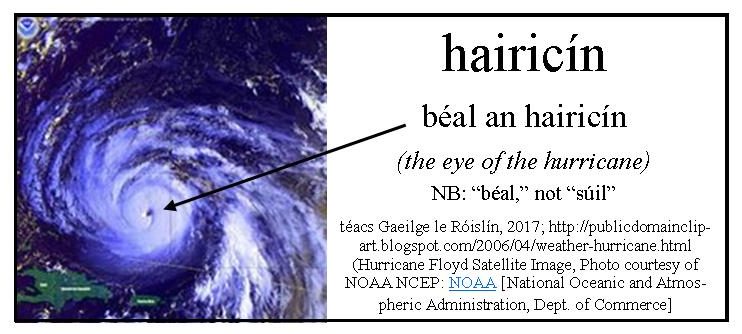Hurricane-related words in the Irish language: Hairicíní, Spéirlingí, Súile, Béil et al. Posted by róislín on Oct 12, 2017 in Irish Language
(le Róislín)
This has been one of the worst hurricane seasons I can remember. Although I, as an individual, can do nothing to stop the destructive path of the hurricanes (bealaí scriosacha na hairicíní), I can at least provide a little vocabulary for discussing them in Irish.
First we’ll look at the two words for “hurricane” and then the basic word for “wind.” Time permitting, or perhaps in a future blog, we’ll also look at words like “gale,” “gust,” and, just for contrast, “breeze.”
The words for “hurricane” to start with:
hairicín, and its various forms:
an hairicín, the hurricane
an hairicín, of the hurricane (same as above)
na hairicíní, the hurricanes
na hairicíní, of the hurricanes (same as above)
The word “hurricane” is clearly an adaptation of the English (hurricane), which itself is an adaptation of the Spanish “huracán,” which is probably derived from the Taíno “hurakán” (storm god). Taíno was a Caribbean Indian language, in the Arawakan family, now extinct, but leaving us a few loan words as its legacy.
There is a more traditional Irish word, “spéirling,” but to me it’s somewhat ambiguous, since it also means “thunderstorm,” which is quite a different kettle of fish from a hurricane. “Thunderstorm,” more specifically, can be “stoirm thoirní.” If you choose to use “spéirling,” here are its forms:
an spéirling, the hurricane, the thunderstorm
na spéirlinge, of the hurricane, of the thunderstorm
na spéirlingí, the hurricanes, the thunderstorms
na spéirlingí, of the hurricanes, of the thunderstorms
An interesting related phrase is “lampa doininne” (hurricane-lamp, lit. a storm-lamp, a lamp for stormy/bad weather), from “doineann” (storm, stormy weather, bad weather).
As for the “eye of the storm” phrase, as seen in the graphic above, the traditional Irish usage is “béal” (mouth), not “súil” (eye). Presumably this is related to “i mbéal na doininne,” often translated as “in the teeth of the storm,” but literally “in the mouth of the storm.” Interesting, “eye” vs. “teeth” vs. “mouth.” Any “eolaithe aimsire” care to weigh in on the topic? Or for that matter, any “anatamaithe meafaracha” (metaphorical anatomists, if such an occupation exists, perhaps a sideline for underemployed English literature majors!)?
Now for the forms of “gaoth,” the word for “wind,” and it looks like gales, gusts, and breezes will have to wait till next time.
an ghaoth, the wind
na gaoithe, of the wind
na gaotha, the winds
na ngaoth, of the winds (no ending, like the root form)
Well, those are the building blocks for further discussion.
And finally, a little opinion piece. Scary as the hurricane news is, here is a headline that’s also a bit scary, language-wise: “Hairicín Ophelia, ceannairí go dtí an Eoraip” [sic, sic, sic, sic], posted at https://www.youtube.com/watch?v=yAq0rwS5m-g. It took me a few seconds to figure out what on earth it was supposed to mean. Got it? Muna dtuigeann tú é, féach sa nóta thíos.
To all the readers of this blog, please stay well and take care. Never has “slán abhaile” seemed to mean so much. -Róislín
Nóta maidir leis an gceannteideal: Hairicín Ophelia, ceannairí go dtí an Eoraip. A “ceannaire” is a “a leader” or “a guide” or “a head (as of a department or division). “Ceannairí” would be its plural, but, hey, it’s not a verb, so it can’t be used to say “Ophelia heads to Europe.” Need I say more? Aistriúchán uathoibríoch, by any chance?

Build vocabulary, practice pronunciation, and more with Transparent Language Online. Available anytime, anywhere, on any device.





Leave a comment: